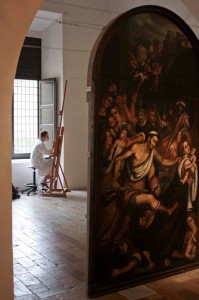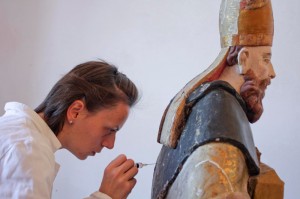Art restoration students save works damaged in a 2009 earthquake—and help heal lives at the same time

An art restoration student works by the painting The Massacre of the Innocents by an unknown artist. This 17th-century painting comes from Navelli, and it was damaged in a 2009 earthquake there. (photo by Timothy Reuter)
The smell of paint fills the quiet, wide room. This is the art restoration lab of the University of Urbino, where professor Michele Papi teaches. Religious paintings, taller than the people who walk past, recline against the walls with sculptures of saints standing close by. On the floor near each piece of art is a slip of paper that describes the work and says where it’s from: One slip says, “Castel del Monte. Mary shows the insignia of San Domenico.”
Seated before some of the paintings are people wearing white overcoats who meticulously mix colors on a palette and delicately daub the artwork in front of them. Their eyes move only between the paintings and the palette, and not to the visitors nearby, as this is a skill that requires a great level of concentration. These are Papi’s students, completing the five years required for an art restoration degree. The lab where they work—three well-lighted rooms near the entrance to the Ducal Palace—is always open to the public to display the latest restoration project.
For many of these students, the latest project is special. The art pieces they are working on were damaged by an April 6, 2009, earthquake that devastated the province of L’Aquila, located in the Abruzzo region just south of Le Marche. The paintings and sculptures aren’t all that significant artistically, but they have a different kind of value.
“They have more of an emotional value than they have actual value because they belong to small communities, so they were more special that way,” says Daniele Costantini, a student who participated in the project.
Lucia Arbace, superintendent of art history for the Abruzzo province, agrees. All are worth restoring, she says, because each piece comes from a different church, so each has something unique. “The ecclesiastical heritage is very diverse and heterogeneous,” she says.
[pullquote] Now, after almost two years, the art restorers have finished their work. [/pullquote]The L’Aquila earthquake, with a magnitude of 6.3, was the worst to strike Italy in more than three decades. More than 300 people died and more than 40,000 were left homeless. About 10,000 structures totally or partially collapsed; at least 400 of those were from the Renaissance and Baroque periods. By contrast, the earthquakes in May 2012 in the region of Emilia-Romagna left an estimated 17 dead.
“I was really afraid for my family and for my friends,” says Stefania Paolini, another of Papi’s students, who was born in Castelvecchio Subequo, a village in the L’Aquila province. “One of my friends died.”
The reaction to the earthquake was immediate. Within days, the University of Urbino offered its help to restore some of the damaged art. The Marche Regional Association of Municipalities financed the process, “adopting” one or two paintings from each of several affected villages. The total of chosen pieces came to 17 and included paintings and sculptures. Arbace says, “There was great interest in saving L’Aquila’s artistic heritage.” And now, after almost two years of work, Papi, his coworkers, and their 70 students have finished their task.
“It is beautiful for L’Aquila,” Paolini says.
Costantini and three other students restored one of the works damaged in the earthquake. It is from the town of Popoli, and it is a triptych by an unknown artist depicting Christ, the Madonna with Christ, and Joseph with Christ. Costantini says the steps for restoring a piece of art are always similar, but the process itself depends on the piece. For this painting, he started out by working on the back, the support of the painting. To fix fractures in the support, the restorers dug out the damage and filled the holes with small wooden triangles and sap-like glue. Next the restorers turned to the front of the painting. First, they cleaned it with organic solvents. Then, they filled blank spots with a mixture of glue and chalk. After smoothing these spots with sandpaper, the students restored the image with watercolors and paint. Finally, Costantini brushed a clear synthetic liquid over the surface to preserve the colors.
Though these paintings are from many places and by many artists, Papi says he gives them all the same care. “All paintings are valuable, whether they come from Abruzzo or elsewhere,” he says, “because paintings are the historical memory of our country.”
Papi has restored art for more than 25 years. He studied first at the Istituto Statale d’Arte in Urbino and later at the Accademia di Belle Arti, also in Urbino. Though he specialized in chalcography (copper and zinc engraving), he says restoration is his passion. “One day in 1982 I met a restorer from Florence who was teaching restoration,” he says. “Ever since then I’ve never stopped doing it.”
He sounds confident as he says that the Abruzzo paintings didn’t present any specific challenges. These paintings were damaged and needed restoration, which is something he and his team deal with all the time.
“The real challenge is giving them back to the population,” he says, because of the emotional connection. He will face this challenge at the beginning of July, when, after almost two years of work, the team will return the pieces to Abruzzo. An exhibit of the restored works in L’Aquila will allow people to appreciate the art and the work that was done.
Says Papi, “For them, seeing the paintings they love is a way to go back to go normality.”
This article is from Urbino Now magazine’s Urbino Centro section, which offers an in-depth look at the daily life of Urbino. Please view more magazine articles or order a complete printed copy of Urbino Now.
